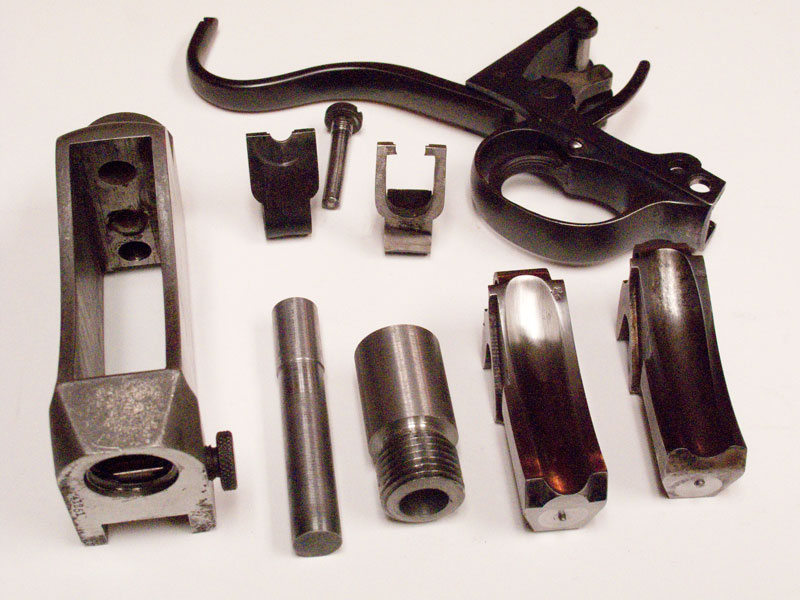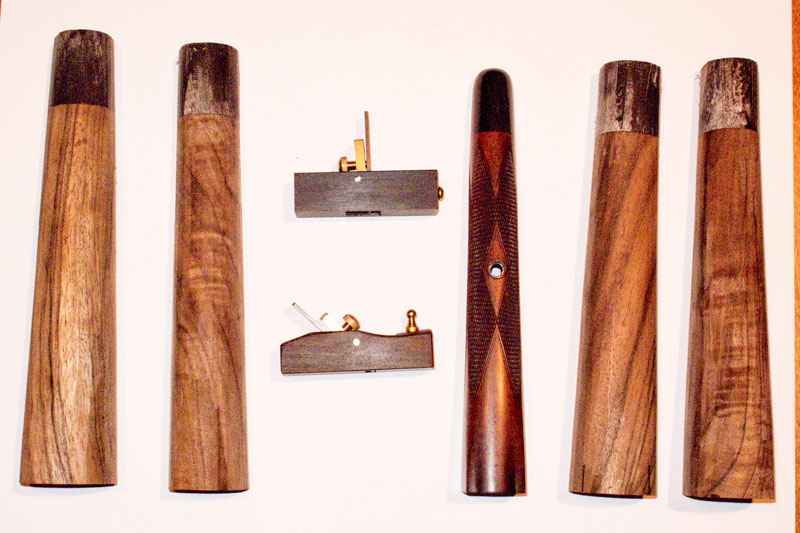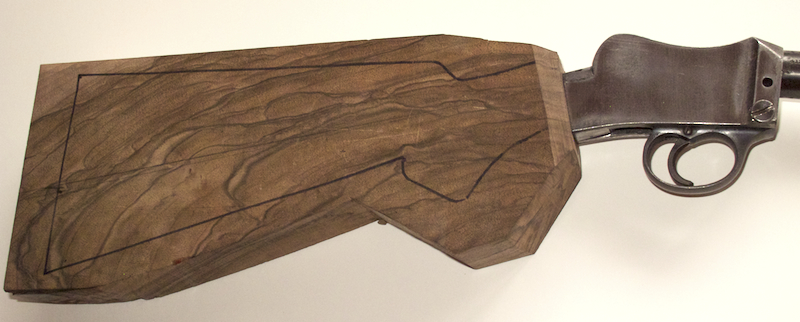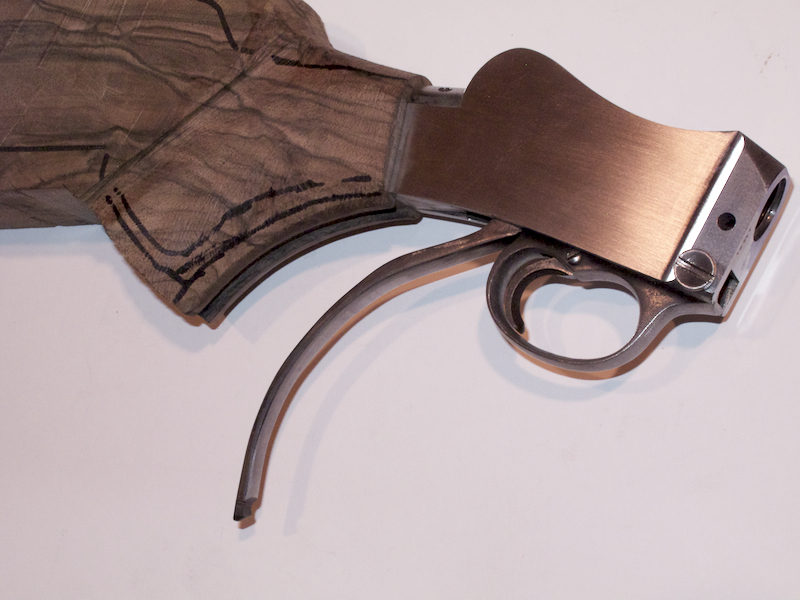Ovate Barrels-Part 2
Ovate Barrels Part 2
While waiting for arrival of the full round .17 caliber barrel I did some preliminary work on the action as well as some of the preparations for the stocking. I made a fixture for lapping the faces of the breach blocks. This is a simple threaded stub (14 t.p.i. .750″ threads) that has a bore of .375″ to accommodate a drill rod lap. I started with 320 grit lapping compound dabbed on the end of the lap which was slowly rotated with a hand drill. This created shallow ‘ruts’ so I used contact cement to attach 600 grit wet or dry paper on the tip and adding a drop of oil a smooth finish was achieved.
To convert the second rimfire breach block I planned to follow the method used on a Hoffman Arms #12 Martini that I have. It has a simple dovetail cut across the breach face from side to side through the existing firing pin hole. A dovetailed blank was then secured in the cut. The firing pin was then ground from the striker, the striker was replaced in the block and the new centerfire pin location was drilled in its new location through the block face and into the striker face. A new firing pin was then fashioned and soldered into the striker. This new location is just below the center of the striker axis.
This arrangement works well but Morris devised an alternative. He completed the first part of the conversion by threading the existing rimmed firing pin hole in the breach face with a 4-40 tap. A screw was then turned into the threaded hole, cut nearly to the face of the breach and TIG welded around this screw protrusion on the breach face. The face was then surface ground and finally lapped. The new firing pin hole will be drilled with a 1/16″ twist drill and a new pin will be fashioned from 1/16″ drill blank stock and soldered into the striker. The striker axis is not perpendicular to the face of the breach block so care will be needed when clamping the block properly for this operation.
The small BSA Martini actions have a heavy, thick through bolt and I wanted to replace this with a smaller 1/4″ one. I started by mading an insert that was threaded on the outside to fit the screw hole in the back of the action and that was center drilled and threaded for 1/4″ 20. A new bolt was then made that had a head diameter of 5/8″.
In Part 1 the issue of a small size of the butt stock blank as well as a bit of sap wood was discussed. The entry and exit holes for the through bolt were located so that the dimensions of the Hoffman Arms Martini could be nearly duplicated for this new rifle.
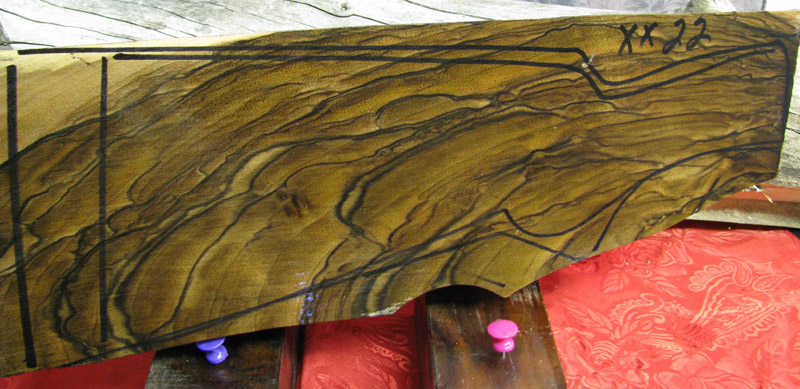
Two gun drill type tools were made from O-1 drill rod, the smaller 5/16″ in diameter and the second had a 5/8″ end section soldered in place, and they were then hardened. The smaller drill was chucked in my metal lathe, the blank was pinioned between centers and the drill was inserted about 4″ from each end. Because the flutes of this drill don’t clear chips well, slow steady pressure was needed and the drill had to be withdrawn frequently to remove the chips. The blank was then secured in a bench vise and the final drilling was done with a 3/8″ chucked hand drill. When I broke through near the center of the blank to the hole from the opposite end there was only the slightest resistance felt so this gave a very straight hole.
Using the second drill with the 5/8″ head that has a short section of the 5/16″ rod protruding from its face to act as a pilot, the 5/8″ section of the hole was drilled. This was a very slow process and required that the drill be removed frequently to clear the chips. This resulted in a clean cut and concentric hole. The final step was to make a 1/8″ thick washer that was .625″ in diameter which was set in its permanent position at the bottom of the 5/8″ section of the hole.
The butt stock was then inletted into the rear of the action.
Each barrel will have its own fore arm and the blanks that I had were difficult for me to picture the best layout. I turned each to a full round on the lathe and this made the task much easier. A 15mm tenon was turned on the front of each blank, a Forstners 15mm bit was used to drill a hole 3/4″ deep in the end of each of the horn tip blanks that I had and then they were attached with cyanoacrylate glue. Each was then roughed to shape and will be inletted when the barrel profiling is done.
The lever was heated and forged to shape and then inletted into the butt stock. Lever tip treatment will be done at a later date. Final dimensions for the butt stock will be established after one of the barrels is completed.
The action surfaces had a uniform roughness generally described as patina. I’d call it very fine surface corrosion. Morris surface ground the sides and the face of the action and I did the preliminary finish to 220 grit by hand.
Readmore

